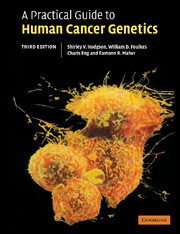Book contents
- Frontmatter
- Contents
- Dedication
- Preface
- Acknowledgements
- Part one Cancer genetic counselling
- Part two Genetics of human cancers by site of origin
- 2 Central nervous system
- 3 Eye
- 4 Cardiorespiratory system and thorax
- 5 Endocrine system
- 6 Gastrointestinal system
- 7 Reproductive system
- 8 Urinary system
- 9 Blood and lymph
- 10 Musculoskeletal system
- 11 Skin
- Part three Cancer-predisposing syndromes
- Appendix
- References
- Index
10 - Musculoskeletal system
Published online by Cambridge University Press: 20 August 2009
- Frontmatter
- Contents
- Dedication
- Preface
- Acknowledgements
- Part one Cancer genetic counselling
- Part two Genetics of human cancers by site of origin
- 2 Central nervous system
- 3 Eye
- 4 Cardiorespiratory system and thorax
- 5 Endocrine system
- 6 Gastrointestinal system
- 7 Reproductive system
- 8 Urinary system
- 9 Blood and lymph
- 10 Musculoskeletal system
- 11 Skin
- Part three Cancer-predisposing syndromes
- Appendix
- References
- Index
Summary
Bone tumours
In general, sarcomas of bone, muscle or connective tissue are rare, especially in children. Bone tumours comprise about 5 per cent of childhood cancers (3 per cent osteosarcomas and 2 per cent Ewing sarcoma) and their incidence overall is about 10 per million persons in the UK. The age-standardised rate of malignant bone tumours for white children (0–14 years of age) in the SEER Registry, 1983–1992 was 6.4 per million. Soft tissue sarcomas are slightly more common (10 per million). The rates are similar for black children in the same registry, except for Ewing sarcoma, which is nine times less common in black children (Parkin et al., 1993).
Osteosarcoma
Osteogenic sarcoma is commoner in males than in females, and shows two age peaks, one at adolescence and a second, which parallels that of chondrosarcoma, in the sixth and seventh decades. The tumour has a predilection for rapidly growing bone and is commoner in Paget disease. One family with three siblings with Paget disease has been reported. Two developed fatal osteosarcoma (Wu et al., 1991). Children with osteosarcoma are significantly taller at time of diagnosis than are unaffected controls (Gelberg et al., 1997). A similar, but not significant difference is seen for children with Ewing sarcoma. Interestingly, large dogs, such as Great Danes are at higher risk for osteosarcoma than are smaller breeds (Owen, 1967).
- Type
- Chapter
- Information
- A Practical Guide to Human Cancer Genetics , pp. 132 - 138Publisher: Cambridge University PressPrint publication year: 2006



